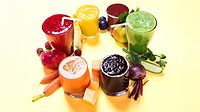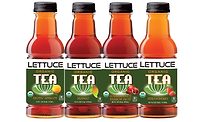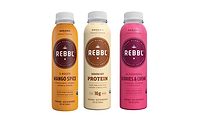Ingredient Spotlight
Pandemic prompts increased citrus usage
Citrus ingredients popular in hard seltzers, budding beverage categories

In the Sesame Street episode “Healthy Food,” Cookie Monster and Wyclef Jean rap “Healthy food, boy it taste so good. Me one healthy dude, ’cause me eat healthy food.” As consumers have taken a greater interest in their immune system, food and beverage manufacturers are incorporating the healthy ingredients that consumers’ desire.
Citing an April 2020 report from FMCG Gurus titled “Twelve Step Guide for Addressing COVID-19 in 2020 and Beyond,” Micah Greenhill, beverage marketing director at Chicago-based ADM, explained that 57% of global consumers report increased concern about their immune system because of COVID-19.
“As a result, more shoppers are seeking out foods and beverages that can help support a healthy immune system. In fact, 87% of U.S. consumers are interested in products with immune boosting ingredients, and 78% of those consumers are interested in vitamin C,” Greenhill says, citing a March 2021 FMCG Gurus report titled “How Has COVID-19 Changed Consumer Behavior.” “Health-signaling flavors and ingredients like citrus have benefited from this focus on immunity.

Image courtesy of The Coca-Cola Co.
“They provide a ‘health halo’ that consumers associate with naturally occurring vitamin C, which may support their immune systems,” he adds. “Plus, using juice from whole citrus fruits can further enhance offerings with added vitamin C, potassium and more. Citrus has certainly taken off and will continue to be paired with health-forward, fortified beverages that boast properties for immune function support.”
Dinah Diaz, global citrus marketing director at Firmenich Inc., explains that the Plainsboro, N.J.-based company launched its first Human Insight Covid Survey at the outset of the pandemic. The survey was designed to help Firmenich better understand and anticipate consumers’ evolving needs and behaviors in relation to food and beverage choices, she says.
“As the pandemic spread, the studies expanded to five complete tracking waves over 12 months, across 22 countries with more than 17,000 consumers polled,” Diaz explains. “We found consumer needs have evolved rapidly, and that when it comes to ingredients associated with immunity support, orange ranked No. 1. Lemon also ranked high on the list as an immunity-booster with the added benefit that consumers perceive that citrus improves mood.
“Our survey also revealed that people are consuming more juices than last year possibly for its perceived health benefits,” she continues. “Brands are leveraging these consumer associations and benefits of citrus for immunity, a recent Mintel report on ‘Citrus in Beverages’ showed that immunity claims in citrus flavored new beverage launches has increased 3% from the previous five years.”

Image courtesy of True Citrus
Ton Mesters, global portfolio director of Citrus for Kerry Taste & Nutrition, Beloit, Wis., also notes the positive image that consumers have when it comes to citrus.
“Consumers perceive citrus as has having a lot of healthy halo in supporting immunity,” he says. “During the pandemic, citrus was more frequently used and usually with other added vitamins and minerals to create immunity supporting products.
“Our Kerry Proprietary Consumer Research on botanicals conducted this year found that 21% of global consumers associate lemon with immune support and 19% do the same for orange,” Mesters continues, citing “Kerry Proprietary Consumer Research - Botanicals 2021” report. “This is significantly higher than for other ingredients.”
Top choice
Given citrus’ association with immune health, it is no surprise that the ingredient remains a popular choice for beverage-makers.
“Citrus is the number one flavor in beverages with 30% of global beverage launches incorporating a citrus taste,” Kerry’s Mesters says. “Using citrus almost guarantees that products will be enjoyed by customers. All citrus are perceived as delivering a fresh refreshing experience that consumers all over the world love. It also brings excitement about emerging citrus flavors.
“Overall, citrus gives consumers a wonderful feeling of reassurance and comfort as they are so well known and have been used in foods and beverages for such a very long time,” he continues.
Firmenich’s Diaz notes that in 2019, Americans consumed about 25 pounds of fresh citrus per capita, further solidifying the ingredients affection with consumers.
“One reason for this love of citrus is that consumers perceive citrus to be healthy and better for you; citrus fruits are rich sources of vitamins, minerals and dietary fiber as well as phytochemicals, a non-nutrient compound believed to help reduce the risk of chronic diseases,” she says.

Image courtesy of Luxco Inc.
“Insights from Firmenich’s Emotions360 global survey, which explores connections between emotions and products, colors and ingredients, revealed that besides hydration, consumers associate citrus flavors with emotional and functional benefits, like refreshment, energy, relaxation and weight control,” Diaz adds, citing the Firmenich Social Listening Study 2019-2020 and its Emotions360 study.
Although consumer affinity for citrus is well-established, experts note there are citrus segments that resonate more than others.
“Orange, lemon and lime continue to be the most popular citrus flavors,” Kerry’s Mesters says. “Our Kerry 2021 Taste Charts research report for the U.S. noted a number of interesting ‘New Age Citrus’ flavors such as yuzu, blood orange, kumquat, bergamot, calamansi, Sicilian lemon and satsuma were in our ‘key’ flavors category for beverages. This ‘key’ category means they have been ranked among the Top 10 to 25 flavors for the last five years. Beverage developers should take a look at these intriguing ‘New-Age Citrus’ flavors.”
Marie Wright, president of creation, design and development and chief global flavorist at ADM, also notes that simple, classic varietals within citrus are the top requests, but that health and wellness is resulting in more adventurous citrus options.
“[W]ith health top of mind, fermented and sour flavors like black limes and preserved lemons are of growing interest, as consumers associate them with digestive health,” she says. “On top of that, food and beverage trends like kimchi and kombucha are also shaping consumers’ palates. With growing acceptance, these fermented flavors are poised to penetrate the general consumer market in the coming months. People are also now more open for exploration.
“Global flavors are enticing shoppers who want to add excitement to their day,” Wright continues. “Yuzu kosho, key lime, flamed orange and blood orange offer a fresh twist on familiar varietals. Citrus combination flavors are very popular across many beverage categories including seltzer, hard seltzer, energy and hydration. Combinations of citrus and tropical flavors like mango and pineapple are refreshing, powerful and have the benefit of masking functional ingredients. Plus, seemingly opposing flavors can make the best combinations and create an unexpected, exciting sensory experience for consumers. For instance, herbs like thyme, basil, rosemary and mint pair exceptionally well with lemon.”
Refreshing expansion
Although juice and juice drinks might be the traditional market for citrus ingredients and flavors, the versatility of its flavors have helped citrus expand beyond this delivery method.
“Beyond freshly-squeezed juices, seltzers and hard seltzers are other thirst-quenching drinks for easy sipping that continue to resonate with consumers,” ADM’s Greenhill says. “This expanding beverage category provides an ideal format for flavor experimentation, especially with citrus. Seltzer water appeals to a wide range of consumers, and interesting combinations of cranberry clementine or ginger lime are continually popular in this space. Plus, hard seltzers on the market today are combining multiple citrus flavors together such as orange, lime and grapefruit for an extra kick.
“Citrus punch is also emerging in this category, with consumers connecting punch-like flavors with feelings of joy and fun,” he continues. “Additionally, hard seltzer teas are starting to hit the market as beverage-makers keep one foot in what’s currently trending and another in what’s next. Lemon and lemonade flavors are the most prominent in these new beverage developments since they are familiar profiles that traditionally pair well with tea.”
Kerry’s Mesters notes that many beverage categories are including citrus flavors. “Almost 50% of flavored water (48%) and sports and energy drink (47%) product launches include citrus flavors,” he says. “Carbonated soft drinks (34%) and flavored alcoholic beverages (30%) are third and fourth in new beverage launches that include citrus flavors.”
ADM’s Greenhill notes that the vanguard beverage categories ― sparkling water, ready-to-drink (RTD) and RTD coffee ― also are embracing citrus in their new products. He adds that convenience is driving many of these new innovations.
“Convenience is key for many people, and RTD teas and coffees fit the bill. Latest offerings in RTD teas and coffees offer functional nutrition like caffeine or probiotics,” Greenhill says. “Teas, in particular, tend to meet the clean-label trend with closer-to-nature, plant-based and recognizable ingredients. Exotic citrus flavors like bitter orange and yuzu and familiar botanicals like hibiscus and elderflower are being paired together in new RTD tea offerings. RTD citrus and lemonade coffees and kombuchas are also having a moment as consumers look for tasty, energy-boosting and health-forward convenient beverages.”
Clean creations
With citrus utilization in new beverage formulations on the rise, ingredient suppliers also are ensuring that their portfolios are hitting on other in-demand consumer trends.
“Consumers are also demanding natural and clean-label offerings, especially in EU and North American markets,” Firmenich’s Diaz says, citing its Conscious Consumer report. “Responding to this demand, beverage brands are demonstrating naturalness through the use of claims such as ‘organic’ or by having minimal ingredients on label while maintaining the products authenticity, freshness and taste.
“This desire for freshness and authenticity led us to launch FreshSlice™, a natural collection of citrus oils,” she continues. “Flavors created with FreshSlice™ taste juicier and fresher with brighter aromatics and true-to-fruit nuances of peel and fruit flesh notes, all of which are pleasing to consumer’s taste palette.”
Citing FMCG Guru 2021 data, Kerry’s Mesters also notes the impact that clean-label trends is having on citrus usage.
“More and more food and beverage manufacturers are seeking out extracts or Natural X flavorings,” he says. “Seventy percent of global consumers in February 2021 said they will be more attentive to natural ingredients due to COVID-19. This is up considerably from 46% in April 2020.”
Trends in clean labels as well as natural and authentic ingredients also influenced the new line from Kerry.
“In particular, we have seen strong demand for Kerry’s NEW! Citrus Extracts, which are stable water-soluble extracts with high impact at low use levels and are fully 100% from the named fruit,” he says. “They can be used in these popular drinks and labeled as a natural extract (not a flavor).”
ADM’s Greenhill adds that natural fruit ingredients allow beverage-makers to position their products as clean label and closer-to-nature, which is influencing the supplier’s portfolio.
“To achieve real citrus flavor that satisfies these consumer label demands, our team at ADM sources citrus oils and juices from around the globe using cutting-edge extraction and distillation techniques,” he says. “We have a gentle cold extraction process for whole fruit extracts, selective concentration for all folding levels, plus comprehensive separation and fractionation technologies.”
As citrus remains in high demand, beverage formulators have a strong network of options to create these next-generation beverages.
Looking for a reprint of this article?
From high-res PDFs to custom plaques, order your copy today!






